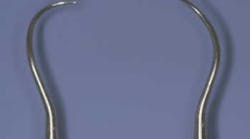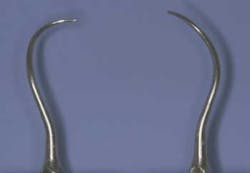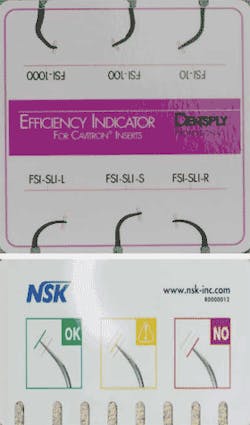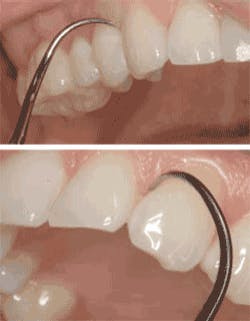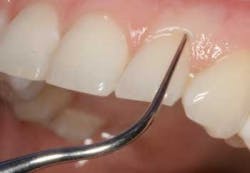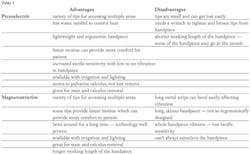Overcoming the hesitation to use the devices all the time
by Sonya L. Prater, RDH, BS, FACE
When you think back to the first generation of ultrasonic scalers, you realize how far dentistry has progressed. Many different types, designs, and uses for scalers are available today. The original ultrasonic scaler, though, was designed to remove decay.
During the past few years, I used one of those "ancient" units daily, but only for removing calculus. This proved a theory, my fellow hygienists, that dentists have great difficulty spending money on their hygiene departments.
While using the "old timer," I first felt like a woodpecker just pecking away at the enamel. No matter how low I turned down the unit's frequency, it still seemed too aggressive and dangerous.
If for some reason, you are not using an ultrasonic scaler routinely in your dental practice, then I must ask the question, "Why not?"
In hygiene school, we had the opportunity to use an ultrasonic scaler only a few times. It was really more of a practice session. Because of that limited exposure, I wasn't sure if I believed in ultrasonic technology. The initial impression was that it was too difficult to see what I was doing due to having all of that water to deal with. More experience with ultrasonics over the years has helped shaped my thoughts and opinions. I now could not possibly practice without an ultrasonic scaler.
The two very popular types of ultrasonic scalers today are magnetostrictive and piezoelectric.
Magnetostrictive
- 18,000 to 45,000 cycles per second.
- Movement generated by electrical current passing over a stack of metal strips or a metal rod which is attached to the insert.
- The insert/tip movement may be linear or elliptical.
- All surfaces/sides of the insert tip are active.
Piezoelectric
- 25,000 to 50,000 cycles per second.
- Movement generated by electricity passing over crystals in the handpiece.
- The insert/tip movement is linear.
- Two sides of the insert/tip are active.
Most, if not all ultrasonic insert manufacturers have a universal tip/insert, but a multitude of tips may be better suited for certain procedures and particular areas of the mouth.
For example, I personally favor my right and left curved tips (see Figure 1). Have you ever struggled to get a piece of calculus from a slightly concave interproximal surface? Or, how about subgingivally, or distal of the second or third molars? Using the appropriate tip can save a lot of time, which also translates to money.
I admit that I'm a sucker for new stuff, so I don't usually hesitate to try new products. As a matter of fact, I usually try to get a sample to try, if possible. Obviously, companies such as Dentsply, Hu-Friedy, Brasseler, Parkell, and others are not readily giving out samples, but many of them do have guarantees. If you want to try different manufacturer's tips or inserts, I would suggest a hands-on seminar. Many presenters have several tips from different manufacturers available for use.
Figure 1: Piezo right/left tips. These tips allow access in hard-to-reach areas of the mouth, including furcations.
Recently, my office purchased a piezoelectric unit. I was initially unimpressed. After all, I was used to Cavitrons and was happy. I would have gladly handed this piezo unit back, but then I received training with it. Both units are great, but remember that instrumentation is the key with any unit.
Figure 2: Efficiency Indicator for Cavitron inserts above indicates the level of wear. Tip indicator for piezo below allows the operator to see when the inserts are no longer effective.
Some instrumentation factors are:
- Tip wear
- Tip length
- Site specific tips for particular areas of the mouth
- Universal tips
- Power settings
- Water output
- Irrigation
- Lighting
In addition, you must be certain of one thing: the tip must not be worn to the point that it is ineffective, thus making the scaler and the operator – you – inefficient!
Figure 3: Right curved tip above may be used subgingivally and around healthy tissue. Hard-to-reach interproximal areas are also perfect for this tip. Left curved tip below is adapted to mesial of tooth No. 11. The slender tip makes cleaning under healthy tissue ideal.
I try to narrow my choices of units in order to keep my life simple. My preference for a magnetostrictive unit is Dentsply Professional's Cavitron. For piezo, I prefer the Brasseler unit. Keep in mind, though, that there are many very good, reasonably priced, effective units. Do some research, and visit with the manufacturers while at a dental show, or check out their Web sites. Each manufacturer offers their versions of trials, guarantees and warranties. It's important that you are comfortable with the type of unit, as well as the folks who you'll be dealing with when your unit needs to be serviced.
Figure 2 shows indicators for efficiency for each type of ultrasonic scaler. Checking your tips regularly is as important as having sharp instruments. Try cutting a steak with a butter knife. Having a full-length ultrasonic tip is the equivalent of having a sharp steak knife.
The periodontal condition of your patient is also key. If you don't know that a 6 mm pocket exists, then how effective do you think you'll be in removing the debris at that depth? Consider pocket depth before choosing the appropriate tip length. Some tips are designed for healthy gum tissue and others for reaching those deep pockets. Don't operate blind – probe often!
I believe that site/area specific tips are the best invention since sliced bread. When I first saw the right and left curved tips, I wondered how I was going to adapt those tips in a mouth. After using them, though, I was amazed by how much of the tooth I could access.
I always use a periodontal explorer so that I can easily access subgingival and interproximal surfaces. At times, I could feel an area of calculus, but not be able to remove it with a universal tip. I easily reached those areas with the right or left curved tip (see Figure 3). These tips are also helpful in gaining access to furcations – the most difficult locations to debride.
Universal tips just aren't that universal. You can use them just about anywhere in the mouth, but that doesn't mean that doesn't mean that they are the most effective tips. For healthy tissue, where there is hardly a need to go subgingivally, especially if the patient has little to no calculus, the universal tip is totally acceptable (see Figure 4).
The power settings for any type of ultrasonic scaler need to be carefully considered. The rule of thumb is this: Use the least amount of power needed to get the job done. I'm not sure where the misnomer of "more is better" came from, but in most cases, more is not better! You can damage healthy tooth structure if you are not careful with your selection of power setting for the task. If you control your settings, you can provide a more efficient prophylaxis, do less damage to the enamel/cementum (in many cases, cause no damage), and keep your patient comfortable through the process.
One interesting detail that I've noticed while using my piezo unit is that I'm able to use less water, since it's not necessary to use a lot of water to cool the tips. The handpiece just doesn't heat up like the magnetostrictive units do. Many of the older magnetostrictive units require almost a steady stream of water in order to cool the tip and keep the patient comfortable. You don't want to make the evening news because your patient drowned during the procedure! Adjust the water so that it is a mist along with a drop about every second.
An exciting breakthrough and feature for many current ultrasonic units is the use of irrigation. Honestly, the old way of irrigating (many times using a needle) deterred me from doing this step. Now, irrigating has never been so easy. With the simple push of a button and change of a tip, I can irrigate the entire mouth quickly and easily – plus I don't have to worry about puncturing the tissue while doing this procedure.
Having access to see clearly is also something to consider when choosing an ultrasonic unit. Fiber-optics have made their way into the hygiene operatory in different forms. Lighted handpieces are just one of them and contribute to easy instrumentation. If you can't see where you are in the mouth or how you're adapting your instrument tip, then your efforts are futile. You can't have too much light when working in the mouth; actually, this is a case where "more is better!"
In comparing hand instruments vs. ultrasonic scalers and inserts, the outcome is similar. When you consider the means by which you have to get there, the path is very different. At some point in my career, I noticed that my right forearm was visibly more muscular than my left forearm (I am right-handed). It was due to the amount of hand scaling that I did on a daily basis. On the weekends in particular, I would have pain running through my fingers, hand, and arm due to the occupational hazard.
Since I've learned how to use ultrasonic technology well, I don't have quite the workout to my right arm as I used to. There is still a noticeable difference in the size of my forearms (which I guess means that my left arm needs to hit the gym!) and I still do some hand scaling – but, it's much, much less these days. With all of this great technology at our disposal, we would be foolish not to take advantage of it.
In summary, I've listed some advantages and disadvantages regarding piezoelectric and magnetostrictive ultrasonic units in Table 1.
Again, if you don't currently use an ultrasonic unit of some sort, I strongly advise that you do some research and find a model that you're comfortable with and that works well for the way you practice and for the types of patients you see. If you do have a unit and are not using it regularly, I challenge you to begin using it for the next 30 days. See if you don't notice a significant difference in your efficiency level.
Don't hesitate to call the manufacturer and get some technical guidance if you are not quite familiar or comfortable with the unit you have. Most manufacturers have a technical staff to assist with unit set-up and operation – not to mention some trouble-shooting too, if needed.
I guarantee that your patients will be responsive to this new method and will most likely make comments on how much cleaner their mouths feel, and possibly how much more comfortable their cleaning appointments were!
Sonya Prater, RDH, BS, FACE, graduated from Western Kentucky University and has been in private practice for 16 years. Having held eight state licenses, she remains in active status in North Carolina, South Carolina and Georgia. She is currently practicing in Savannah, Ga., in a very progressive, customer service driven dental office that specializes in highly complex and reconstructive TMD cases. As a member of the Niche Practice Seminars, she is dedicated to developing a highly specialized program that will raise the bar for dental hygiene as we know it.
Past RDH Issues
